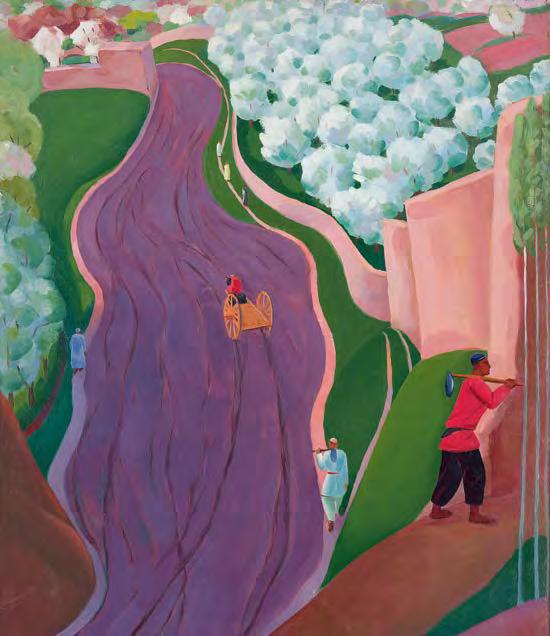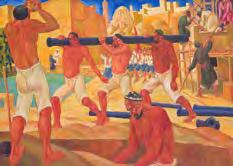
4 minute read
Highlights Guides
COLLECTION HIGHLIGHTS
Collection Highlights: I. V. Savitsky Karakalpakstan State
Museum of ArtThe state museum of art of the Republic of Karakalpakstan named after I.V. Savitsky was founded in February 1966 by the £9.95 / $14.95decree of the Government of the Republic of Karakalpakstan. The Publication: April 2022 80 pages; pb museum’s first director was lgor Vitalievich Savitsky – an artist from Moscow, who connected his life with Karakalpakstan. From the first day of his acquaintance with the culture of this region, 190 × 165 mm (6.5 × 7.5 in.) I.V. Savitsky was interested in the archaeological findings 978 1 78551 344 2of Central Asia. Later he discovered a world of Russian and Turkestan avant-garde. I.V. Savitsky started gathering artworks of Published as part of an extensive well-known artists and formed a unique collection of the museum in a short period of time, having the support and confidence of the programme promoting the rich Government and intelligentsia of Karakalpakstan. cultural heritage of the Republic Today the museum’s collection includes about 100 000 pieces of Uzbekistan in collaboration of items, and covers chronologically more than four thousand with the Art and Culture years, and according to experts, it is the best art collection in Development Foundation Central Asia. It has archeological artifacts, found on the sites of of the Republic of Uzbekistan.ancient Khorezm, the objects of Karakalpak folk and applied arts, and the most well-known art pieces are the art works of Russian and Turkestan avant-garde, Western European art pieces. The Also available in French, Russian collection of Russian avant-garde of the museum is the second and Uzbek editionsafter the State Russian Museum (Russian Federation).
The State Museum of Art of the Republic of Karakalpakstan named after I.V. Savitsky was founded in February 1966 by decree of the Government of the Republic of Karakalpakstan. The museum’s first director was lgor Vitalievich Savitsky (1915–1984) – an artist from Moscow who had a long connection with Karakalpakstan. Today, the museum is home to around one hundred thousand items spanning more than four thousand years, and according to experts it is the best art collection in Central Asia. The first in a series of books on the museum collections and cultural heritage of Uzbekistan, this title features examples of applied art and design and the best-known paintings by Alexander Volkov, Robert Falke, Mikhail Kurzin, Nikolay Karakhan and many others.
Nikolay Karakhan (1900–1970) Laying the Water Pipes in Bukhara, early 1930s
Oil on canvas 89.5 × 124.5 cm
Nikolay Karakhan was born in the Caucasus but lived in Central Asia all his life. All his creative work is connected with the region. Karakhan’s close association with A.N. Volkov, which began in the mid-1920s, had a profound influence on his development as an artist. From 1931 to 1932, Volkov gathered around him a group of young artists who became known as the ‘Volkov Brigade’. Nikolay Karakhan joined the group, together with Ural Tansykbaev, Alexey Podkovyrov and Pavel Shchegolev. The task of the group was to create a national style that would combine the traditions of Western and Eastern art. In the spirit of those creative times, regular ‘creative work trips’ were undertaken by the Brigade to capture the heroics of everyday life on canvases. The painting Laying the Water Pipes in Bukhara depicts one of the key construction events under socialism in Bukhara – the laying of a water pipeline. Water is extremely important in Central Asia. It is difficult to imagine this today, but back in the late 1920s, residents of Bukhara, a city of many thousands, got their drinking water from open reservoirs (khaus) located throughout the city, and this led to numerous infectious diseases among Bukharians. This explains why a seemingly mundane construction site became such a significant event. Karakhan has given the construction of the water pipeline an epic feel. The muscular, half-naked men look like Atlanteans who are not just carrying a pipe but appear as if they are holding up the vault of heaven. In the foreground, the man with his back to the viewer is drinking water, which conveys the essential significance of what is happening – clean water that can be drunk without fear is being made available. Karakhan depicts contemporary realities in the central plane, where we can see a marching unit of Pioneers and a traditional water tank (a khaus) with people standing on its steps. On the right, builders are restoring a medieval monument, showing their respect for the past. In the background, Karakhan has created an architectural fantasy out of silhouettes of the famous medieval monuments of Bukhara. Despite the painting’s small size, it gives the impression of being a monumental mural.
38 | I.V. SAVITSKY KARAKALPAKSTAN STATE MUSEUM OF ART layINg THe waTeR pIpes IN BUKHaRa | 39






